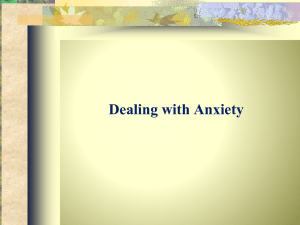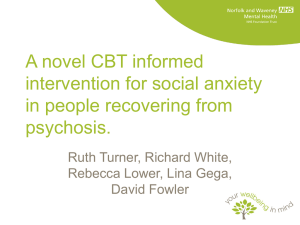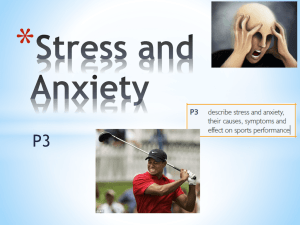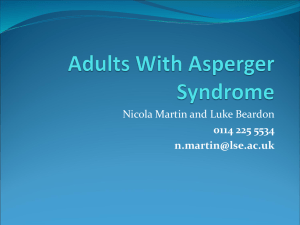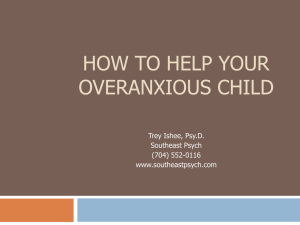Childhood and Adolescent Anxiety
advertisement
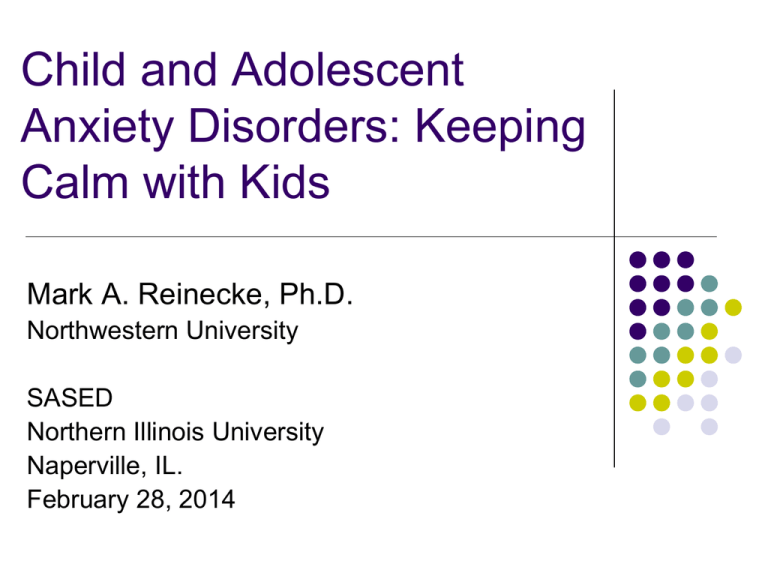
Child and Adolescent Anxiety Disorders: Keeping Calm with Kids Mark A. Reinecke, Ph.D. Northwestern University SASED Northern Illinois University Naperville, IL. February 28, 2014 COI Disclosure Brian Harty Foundation HRSA – GPE Psychology Training Grant (PI) We’re Living in a Worried World Every life has it’s share of anxiety, worry, fear and dread… Unemployment Terrorism Deficit & Financial Security Saving for Retirement Global Warming Worries In Everyday Life Scheduling activities for 3 kids Bullying at school How will my son do on the ACT? Credit card debt Sick pet My hot water heater died Caring for grandparents Chronic illness My son shags cigarettes…is he drinking? Empty nest…kids leaving Boomerang…kids returning Twenty Lessons Lesson #1 Lesson #2 Lesson #3 Lesson #4 Lesson #5 Lesson #6 Lesson #7 Lesson #8 Lesson #9 Lesson #10 Lesson #11 Lesson #12 Lesson #13 Lesson #14 Lesson #15 Lesson #16 Lesson #17 Lesson #18 Lesson #19 Lesson #20 Anxiety…it works Anxiety—The Big A We overestimate risk when we’re afraid The future is uncertain Influence and control You have the power to control the level of anxiety you feel Perfect solutions don’t exist Sometimes bad things are controllable; sometimes not. Intrusive thoughts are normal. It’s the meaning that counts. Dwelling on problems impairs one’s ability to cope. Worrying is highly over rated. Do not magnify the importance of your physical sensations It’s time to relax Evaluate your thoughts themselves Changing your thoughts Avoiding problems is among the worst things one can do. Social Anxiety – Worrying a bit too much what others think What’s really on your mind? Flow with the current of life Live wisely Lesson 1. Anxiety…It Works What exactly is anxiety? Based in Limbic system A normal, highly adaptive emotional state Facilitates response to a perceived threat A Plate with C. Elegans Sydney Brenner, D.Phil South African biologist Worked Now at CRC, Cambridge University at Salk Institute Nobel Prize in 2002 Established C. Elegans as a model organism to study genetics and cell development. First Complete Genetic Map 100 million base pairs ~20,000 genes A Simple Nervous System Nervous system consists of 302 neurons that form a small-world network Their interconnections have been completely mapped out C. Elegans Lesson 2. Anxiety…The “Big A” Anxiety has 4 components 1. 2. 3. 4. Affect Physiological Cognitive Behavioral Organizes perception, memory, & action What Do Children Worry About? Five Factor Model (Ollendick, 1983) 1. 2. 3. 4. 5. Failure & Criticism Unknown Injury & Small Animals Danger & Death Medical Fears Child Psychoeducation – Anxiety Parent Psychoeducation - Anxiety Developmentally Appropriate Fears 1. Infancy: Separation, strangers 2. Early childhood: Loud noises, dark, doctors, animal 3. Middle childhood: Frightening events (Scary movies) 4. Adolescence: New experiences, social rejection Parent Psychoeducation - Anxiety Child Psychoeducation - Anxiety Normal Fears of Childhood Normal Fears of Teens Epidemiology 5-18% of all children and adolescents 80% of adults with anxiety disorders report anxiety symptoms prior to 18 yrs High levels of comorbidity Increased risk of anxiety, substance abuse, and depression in adulthood Impaired academic, social, family functioning DSM-IV Anxiety Disorders Obsessive-Compulsive Disorder (OCD) Generalized Anxiety Disorder (GAD) Post Traumatic Stress Disorder (PTSD) Panic Disorder Separation Anxiety Disorder Social Phobia, Social Anxiety Simple Phobia Atypical Anxiety Disorder (School Phobia?) Serious Anxiety is Common GAD Social Anxiety Selective Mutism Specific Phobias Separation Anxiety Panic PTSD OCD 2-5% 3-18% >1% 3-20% 3-5% 1% 6% 1-4% Comorbidity: Number of diagnoses in an anxiety disordered sample 45 40 35 30 25 20 15 10 5 0 One Two Three Four Of 106 consecutive cases (%) Five Etiology and Maintenance Etiology Genetics Environment Temperament (shy, inhibited, risk averse) Parent Psychoeducation - Anxiety Heritability of Psychiatric Disorders Heritability Psychiatric Disorder Zero 20-40% Other conditions Language, Religion Anxiety, Depression Bulimia Myocardial Infarction Breast Cancer, Hip Fracture, Personality 40-60% Alcohol, Drug Dependence Blood Pressure, Adult Onset Diabetes, Plasma Cholesterol, Asthma 60-80% Schizophrenia, Bipolar Disorder Weight, Bone Density 80-100% Autism Height, Brain Volume Brain Metabolism in OCD Basal Ganglia (Caudate) R. Anterior Cingulate R Orbitofrontal Cortex The Essence of Anxiety Fearful Anticipation Rumination, Worry Vigilance Autonomic Arousal Avoidance Parent Psychoeducation - Anxiety The Anxious Individual Cognitive contents incorporate themes of danger and vulnerability. They view the world as a dangerous place, and feel incapable of preventing or managing these risks. Threats may be physical, social, or psychological. Anxiety serves an adaptive function in preparing the individual to avoid threat. Parent Psychoeducation - Anxiety Anxious Children Tend To: 1. Experience their moods more intensely 2. Demonstrate poor affect regulation 3. Feel they are unable to manage situations 4. Show inappropriate emotional expression 5. Be viewed as labile, inflexible, negative Parents, Parenting & Child Anxiety Family/parenting styles (inconsistent findings) Mothers (intrusive involvement in situations with negative affect) (Hudson, Comer & Kendall, 2008) Fathers (limited risk-taking play behavior; unpredictable, punitive, explosive) (Bogels et al, 2007; Hughes, Furr, Sood, Barmish, & Kendall, 2009) Learning Theories 1. Classical conditioning (E/RP) 2. Operant conditioning (Contingency management) 3. Vicarious or observational learning (modeling) Use all three in formulating and treating Assessment Making the Diagnosis K-SADS-PL Anxiety Disorders Interview Schedule for DSM-IV (ADIS-C/P) Assessing Fears and Anxieties Observational Methods Behavioral Avoidance Tests (BATs) Parent / Teacher / Clinician Ratings Monitoring - Anxiety Assessing Fears and Anxieties Think-aloud procedures Thought-listing procedures Cartoons with “thought bubbles” Fear Thermometer Self-Monitoring -Anxiety Assessing Fears and Anxieties Physiological Methods Heart rate Sweat index Respiration Finger pulse volume Monitoring - Anxiety Assessing Fears and Anxieties -Self Report Methods Fear Survey Schedule for Children (FSSC) Scale for Child Anxiety Related Emotional Disorders (SCARED) Social Phobia and Anxiety Inventory for Children (SPAI-C) Negative Affectivity Self-Statement Questionnaire (NASSQ) Spence Children’s Anxiety Scale (SCAS) Monitoring - Anxiety Assessment Instrument Our Favorites Multidimensional Anxiety Scale for Children (MASC) Pediatric Anxiety Rating Scale (PARS) Monitoring - Anxiety Treatment Techniques & Strategies William James “The first fact for us… is that some form of thinking goes on.” Milton “The mind is its own place, and in itself, can make a Heaven of Hell and a Hell of Heaven.” William Shakespeare “There is nothing either good or bad, but thinking makes it so.” Hamlet Act II, Scene II Assumptions of Cognitive Therapy 5. Cognitive Specificity Hypothesis: Moods and clinical disorders may be distinguished on the basis of cognitive contents and processes. If you change cognitions, one can manage anxiety Cognitive Concomitants of Anxiety 1. 2. 3. 4. 5. 6. Increased Vigilance Hypersensitivity to Threat Cues Appraisal of Situations as Threatening Overlook Safety Cues High Standard for Security or “Guarantees” Threat-Related Imagery These are the targets of treatment Cognitive Therapy in Practice Time limited, brief Problem-oriented, focused, strategic Collaborative therapeutic relationship Empirically-based, “Personal Scientist” Structured, active (agenda, homework) Clear & consistent focus on cognitive contents and processes, skills. Lesson 3. We Overestimate Risk When We Are Afraid ƒ (impending threat) (impaired coping) Anxiety= The specific nature of the fear will differ depending upon the perceived threat. Cognitive Formulation -Salkovskis Increased estimate of likelihood Increased estimate of “awfulness” Increased perception of responsibility Lesson 4. The Future is Uncertain 1. The hardest lesson of all 2. However much we would like a guarantee, we can’t have it 3. To feel secure, we must accept ambiguity Lesson 5. Influence and Control Increased estimate of likelihood Increased estimate of “awfulness” Increased perception of responsibility Control exists on a continuum of “degrees of influence” Lesson 5. Influence and Control Lesson 7. Perfectionism Do you believe… For every problem there is a single, best solution? There’s always room for improvement? Perfection can and should be pursued, no matter what the cost? One should expect the best, and settle for nothing less? Maniacal Perfectionism "I'm a maniacal perfectionist. And if I weren't, I wouldn't have this company. .. It's the best rap! Nobody's going to fault me for that. I have proven that being a perfectionist can be profitable and admirable when creating content across the board: in television, books, newspapers, radio, videos. .. All that content is impeccable." Martha Stewart (2000) Being Imperfect… is highly desirable “Trying to be perfect may be sort of inevitable for people like us, who are smart and ambitious and interested in the world and in its good opinion. At one level it's too hard, and at another, it's too cheap and easy. It requires you mainly to read the zeitgeist of wherever and whenever you happen to be…and be the best of whatever the zeitgeist dictates or requires. When you're clever you can read them and do the imitation required. But nothing important, or meaningful, or beautiful, or interesting, or great ever came out of imitations. The thing that is really hard, and really amazing, is giving up on being perfect and beginning the work of becoming yourself. Anna Quindlen (1999) Lesson 7. Perfect Solutions Don’t Exist • Perfect doesn’t exist, conceptually or in practice • Perfectionism is highly correlated with both depression and anxiety • Failure to meet “ideal” standards is associated with stress and guilt • In a changing world, flexibility and creativity are more valuable than a relentless pursuit of perfection Lesson 8. Sometimes You Can Take Control… “I should have seen this coming” “If only I had ____, we’d be OK” Perceptions of responsibility and control are linked to mood Did I actually cause this event? Did other factors contribute? How much “influence” do I actually have? Lesson 9. Don’t Dwell on That… Rumination is common Content of thoughts similar in anxious and non-anxious individuals Secondary cognitions differ What Can Be Done? 1. Mindful Acceptance “It’s just a thought” 2. Rational Disputation Challenge the secondary cognition 3. Desensitization Schedule Rumination…30 minutes a day What’s the solution? Lesson 14. Evaluate Your Thoughts & Make Then Give Good Account of Themselves 1. What’s the evidence? 2. Is there another, more adaptive, way of looking at this? 3. So what? a) Decatastrophize everything. Is it really that big of a deal? b) What can be done? Downward Arrow 1. If I don’t get into Yale, it would be catastrophic! 2. 3. 4. 5. 6. 7. OCD-Intrusive Thoughts Negative intrusive thoughts are common. Intrusive thoughts are experienced by 90% of individuals (Rachman & DeSilva, 1978). The content of intrusive thoughts does not distinguish patients with OCD. Appraisals of thoughts and beliefs about the need to control negative thoughts does distinguish patients with OCD. Caregiver Psychoeducation Steven King Oh no! I’ve got to stop thinking that! vs. Buckets of blood at the prom. Cool! I’ll write a screen play! Appraisal in OCD Individuals with OCD perceive their thoughts as: more distressing more uncontrollable less acceptable more important These appraisals serve as clinical targets. Intrusive Thoughts You just can’t stop the flying monkeys! Hail Dorothy! CBT principals for OCD Basis for CBT is same for children as adults Exposure – facing the fear, trigger obsessive thoughts and anxiety Response prevention – not performing the ritual that decreases anxiety after the exposure; preventing compulsive rituals Exposure, Activity Selection, Relaxation How I Ran OCD Off My Land March, Mulle, & Herbal (1994) Four Stages, 16 session protocol Session 1: Neurobehavioral Model Session 2: Make OCD the problem Session 3: Mapping OCD Sessions 4-12: Exposure Caregiver Psychoeducation, Monitoring, Exposure Temple “FEAR” Program F Feeling frightened? Monitor E Expecting bad things? Cognitions A Attitudes & Actions. Coping R Results & Rewards Reinforce Kendall’s “Coping Cat” 1. 2. 3. 4. 5. 6. 7. 8. 9. 10. Build rapport, socialize to treatment Identify feelings, distinguish anxiety Identify somatic responses (F-step) Parent session Relaxation exercises, monitor tension Identify thoughts, self talk (E-step) Relaxation and cognitive change (A-step) Self-rating performance, reward (R-step) Parent session Practice FEAR Lesson 19. Flow With the Current of Life “By letting it go, it all gets done… But when you try and try, the world is beyond winning.” Lao Tsu Go With The Flow of the River Be Like a Stick Lesson 20. Live Wisely • • • • • • • • Judicious use of knowledge Open minded Altruistic, empathic Compassion Self-reflection Insight Tolerance Awareness of larger issues The Road to Wisdom Keep Calm and Carry On Summary… What Works Keep in mind that anxiety works for you Think clearly. Keep problems in perspective Approach the things you fear Exposure, exposure, and more exposure Active problem solving, solution-focused thinking Balance active coping with mindful acceptance Take the long view, the larger view Live with faith, hope, and equanimity Components of Effective Treatment Psychoeducation Relaxation Behavior management (reinforcement) Modeling Problem Solving Exposure Behavioral Treatments Develop fear hierarchy Relaxation / Breathing / Pleasant Imagery Modeling Systematic Desensitization Prolonged Exposure, Flooding Contingency Management Self-Management Combined Cognitive: Anxiety, Modeling, Self Monitoring, Exposure CBT Tool Kit Develop fear hierarchy Exposure Self –monitoring (Fear thermometer) Problem solving Rational Disputation; Adaptive SelfStatements Contingency management Cognitive: Anxiety, Exposure, Modeling, Relaxation, SelfMonitoring Clinical Outcomes An Empirically-Supported Approach Kendall (1994) First RCT of CBT with Anxious Youth N=47 9-13 years old CBT vs. Wait List Control Treatment: 16 sessions of Coping Cat Respondents: Self-report, parent, teacher Measures: ADIS, RCMAS, STAIC, FSSC-R Clinically significant improvement; Diagnosis free at 1 year follow-up: 60% vs. 10% JCCP. (1994), 62: 100-110. Kendall et al. (1997) Follow-Up CBT vs. Wait List Control Treatment: 16 sessions of Coping Cat Respondents: Self-report, parent, teacher Measures: ADIS, RCMAS, STAIC, FSSC-R Clinically significant improvement; Diagnosis free at 1 year follow-up: 71% vs. 7% JCCP (1997), 65: 366-380. CBT for OCD Probably a “Well Established” Treatment” March et al (1994) Piacentini et al. (1994) Knox et al. (1996) Scahill et al. (1996) Weever et al. (1997) Fischer et al. (1998) Franklin et al. (1998) Thienemann et al. (2001) Waters et al. (2001) Piacentini et al. (1999, 2002) n=15 n=3 n=4 n=7 n=57 n=15 n=14 n=18 n=7 n=42 open trial open trial open trial open trial open trial open trial open trial open trial open trial open trial POTS Pediatric OCD Treatment Study CBT; Sertraline (Zoloft); Combo; PBO N=112 7-17 years old Measure: YBOCS Multisite, double blind PBO controlled Results: 12 week Combo >CBT=Ser >PBO Remission: Combo: 54%; CBT: 40%; Ser: 21%; PBO: 4% POTS Team (2004). Cognitive-behavior therapy, Sertraline, and their combination for children and adolescents with obsessivecompulsive disorder. JAMA , 292: 1969-1976. CAMS: Drop Out by Treatment Condition Treatment Condition Completed Study Dropped Out Total COMB SRT CBT PBO 128 112 134 61 12 21 5 15 15.8% 3.6% 19.7% 133 139 76 8.6% 140 CAMS: Treatment Response 100% 81% 80% 60% 60% 55% 40% 24% 20% 0% COMB CBT SRT % Responder PBO CAMS: PARS Improvement 25 20 15 10 5 0 WK 0 WK 4 COMB WK 8 SRT CBT WK 12 PBO Does CBT Work? Compton et al. (2004) Review of 21 RCT’s of CBT for childhood depression and anxiety indicates that CBT “is currently the treatment of choice” Medium to large effects relative to waitlist, inactive control, active control JAACAP (2004) 43: 930-959 Does CBT Work? Cartwright-Hatton et al. (2004) Review of 10 RCT’s of CBT for child and adolescent anxiety indicates CBT is effective compared to no-treatment control. Remission rate: 56.5% (CBT) vs. 34.8% (control) Brit. J. Clin. Psych., 43: 421-436. What Enhances Improvement? Child involvement (Chu & Kendall, 2004; Braswell, et al, 1985) Therapist “relationship building” strategies (Creed & Kendall, 2005) Therapist flexibility (associated with increased child involvement) (Kendall & Chu, 2000) What Truly Matters Assessment Guided discovery Involvement Cooperative, collaborative rapport Relapse prevention Planning for generalization Arranging termination Individualizing the program Therapist flexibility (with fidelity) What Not To Do (Kendall) Teachy-preachy style Forcing youth to talk about feelings Excessive focus on tasks Mechanical self-talk Tension and upset about scheduling Aversive context (interpersonal conflicts and oppositionality) “Wimpy” role-plays or exposure tasks What we don’t know Proper role for parents in treatment Mechanisms of change How to help treatment nonresponders Active components of the program Effective methods for dissemination Keep Calm and Carry On www.keepcalmthebook.com www.amazon.com www.newharbinger.com




